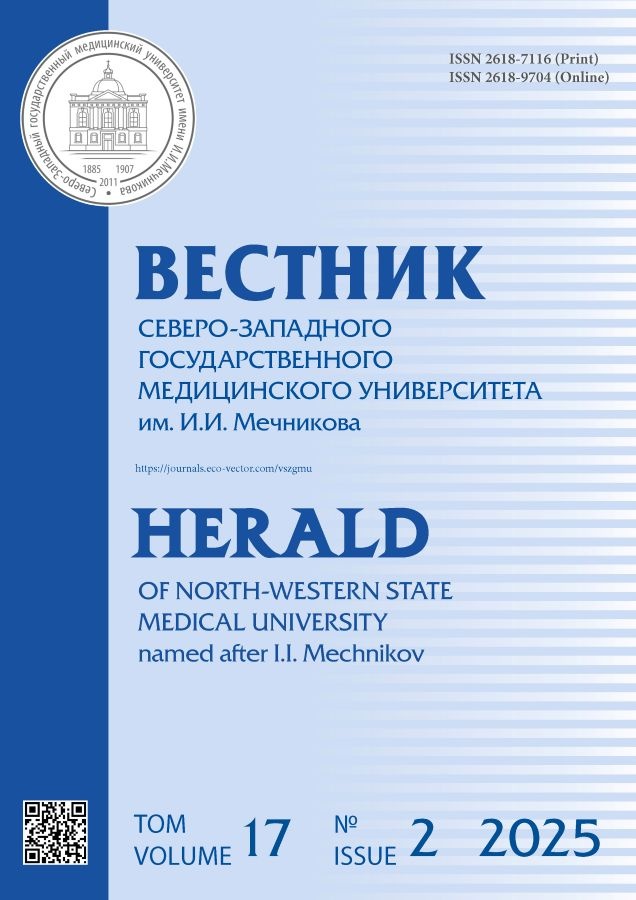Successful treatment of victims with closed abdominal trauma with damage to the duodenum (clinical observations)
- Authors: Demko A.E.1,2, Verbitsky V.G.1,2, Parfenov A.O.1,2, Kolchanov E.A.2, Kosachev A.V.1,2, Yurkevich E.V.1, Mamedov G.A.1, Nagornov D.V.1
-
Affiliations:
- Kirov Military Medical Academy
- Saint Petersburg I.I. Dzhanelidze Research Institute of Emergency Medicine
- Issue: Vol 17, No 2 (2025)
- Pages: 107-113
- Section: Case report
- Submitted: 13.10.2024
- Accepted: 26.05.2025
- Published: 30.06.2025
- URL: https://journals.eco-vector.com/vszgmu/article/view/636986
- DOI: https://doi.org/10.17816/mechnikov636986
- EDN: https://elibrary.ru/OTCSVR
- ID: 636986
Cite item
Abstract
This article presents two clinical observations of successful treatment of victims with closed abdominal trauma complicated by duodenal injury, with an emphasis on key aspects of treatment and prevention of complications.
Injuries to internal organs in closed abdominal trauma pose a serious threat to the lives of victims, especially in cases of damage to the duodenum. Despite the fact that duodenum injuries constitute a relatively small proportion of all abdominal injuries, they are accompanied by a high mortality rate, reaching 30% in isolated injuries and up to 80% in combined injuries. Diagnosis of such injuries is a particular problem. The absence of pathognomonic symptoms, as well as the frequent combination with other injuries (e.g., pancreas, retroperitoneal hematomas, or pelvic fractures) complicates the timely detection of these injuries. In addition, inadequate surgical tactics can lead to severe postoperative complications, including duodenal fistula (2%–16%), intra-abdominal abscess (15%), and pancreatitis (0.5%). The high incidence of severe complications and significant mortality emphasizes the importance of studying effective diagnostic methods, surgical tactics, and postoperative management of patients with duodenal injury.
According to the literature, the incidence of duodenal injury in closed abdominal trauma ranges from 0.6 to 5% of all abdominal injuries. The most common injuries are to the retroperitoneal part of the intestine; the horizontal part is injured in 30%–40% of cases, the descending part in 20%–30%, and the upper part in 15%–22%. A significant problem is the recognition of retroperitoneal ruptures in combination with pancreatic injury and the presence of retroperitoneal hematomas caused by kidney injury or pelvic bone fracture. There are no pathognomonic symptoms of duodenal injury.
Full Text
About the authors
Andrey E. Demko
Kirov Military Medical Academy; Saint Petersburg I.I. Dzhanelidze Research Institute of Emergency Medicine
Email: demko@emergency.spb.ru
ORCID iD: 0000-0002-5606-288X
SPIN-code: 3399-8762
MD, Dr. Sci. (Medicine), Professor
Russian Federation, Saint Petersburg; Saint PetersburgVladimir G. Verbitsky
Kirov Military Medical Academy; Saint Petersburg I.I. Dzhanelidze Research Institute of Emergency Medicine
Email: verbitsky1961@mail.ru
ORCID iD: 0000-0001-6969-7270
SPIN-code: 6981-0621
MD, Dr. Sci. (Medicine), Professor
Russian Federation, Saint Petersburg; Saint PetersburgAnton O. Parfenov
Kirov Military Medical Academy; Saint Petersburg I.I. Dzhanelidze Research Institute of Emergency Medicine
Email: parfenov_anton@mail.ru
ORCID iD: 0000-0002-1192-4087
SPIN-code: 1620-6415
MD, Cand. Sci. (Medicine), Assistant Professor
Russian Federation, Saint Petersburg; Saint PetersburgEvgenii A. Kolchanov
Saint Petersburg I.I. Dzhanelidze Research Institute of Emergency Medicine
Email: di@yandex.ru
ORCID iD: 0000-0001-9716-4981
MD
Russian Federation, Saint PetersburgAleksei V. Kosachev
Kirov Military Medical Academy; Saint Petersburg I.I. Dzhanelidze Research Institute of Emergency Medicine
Email: avkos1@mail.ru
ORCID iD: 0009-0005-2073-6159
SPIN-code: 6137-4356
MD
Russian Federation, Saint Petersburg; Saint PetersburgEgor V. Yurkevich
Kirov Military Medical Academy
Email: yurkeviche1997@mail.ru
ORCID iD: 0009-0006-2090-149X
SPIN-code: 3160-8808
MD
Russian Federation, Saint PetersburgGrigory A. Mamedov
Kirov Military Medical Academy
Email: grisha1132xx1@mail.ru
ORCID iD: 0009-0000-9122-1041
SPIN-code: 3488-6107
MD
Russian Federation, Saint PetersburgDmitrii V. Nagornov
Kirov Military Medical Academy
Author for correspondence.
Email: diman12144@yandex.ru
ORCID iD: 0009-0001-5533-3676
SPIN-code: 8514-7959
MD
Russian Federation, 6 Akademika Lebedeva St., Saint Petersburg, 194044References
- Bonomi AM, Granieri S, Gupta S, et al. Traumatic hollow viscus and mesenteric injury: role of CT and potential diagnostic–therapeutic algorithm. Updat Surg. 2021;73(2):703–710. doi: 10.1007/s13304-020-00929-w
- Coccolini F, Kobayashi L, Kluger Y, et al. Duodeno-pancreatic and extrahepatic biliary tree trauma: WSES-AAST guidelines. World J Emerg Surg. 2019;14:56. doi: 10.1186/s13017-019-0278-6
- Mikhailov AP, Sigua BV, Danilov AM. Damage to the duodenum. Saint Petersburg: ELBI-SPb; 2010. 86 p. (In Russ.)
- Poyrazoglu Y, Duman K, Harlak A. Review of pancreaticoduodenal trauma with a case report. Indian J Surg. 2016;78(3):209–213. doi: 10.1007/s12262-016-1479-9
- Gavrishuk YV, Kulagin VI, Manukovsky VA, et al. Treatment of a victim with blunt abdominal trauma with multiple damage to the duodenum and pancreas: clinical case. The Journal of Emergency Surgery named after I.I. Dzhanelidze. 2024;(15)30–36. EDN: KDTNHP doi: 10.54866/27129632_2024_2_30
- Ordoñez CA, Parra MW, Millán M, et al. Damage control in penetrating duodenal trauma: less is better – the sequel. Colomb Med (Cali). 2021;52(2):e4104509. doi: 10.25100/cm.v52i2.4509
- Abdel-Aziz H, Dunham CM. Effectiveness of computed tomography scanning to detect blunt bowel and mesenteric injuries requiring surgical intervention: a systematic literature review. Am J Surg. 2019;218(1):201–210. doi: 10.1016/j.amjsurg.2018.08.018
Supplementary files












